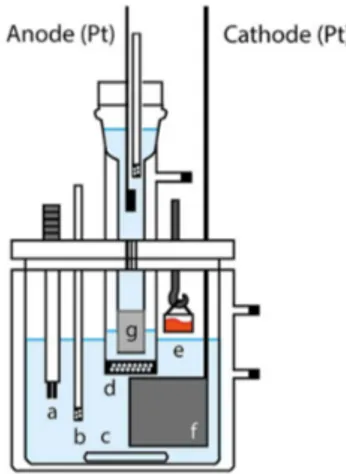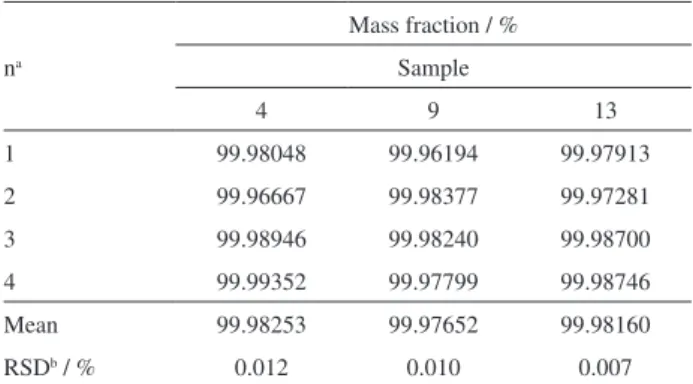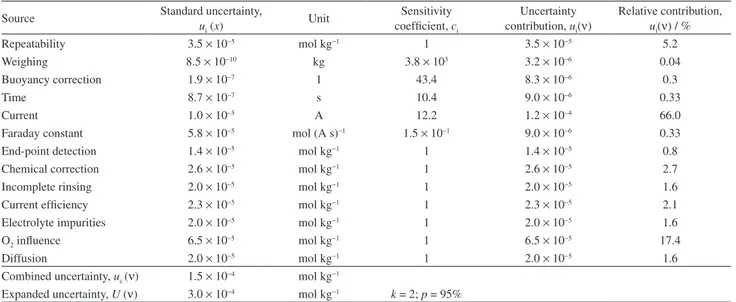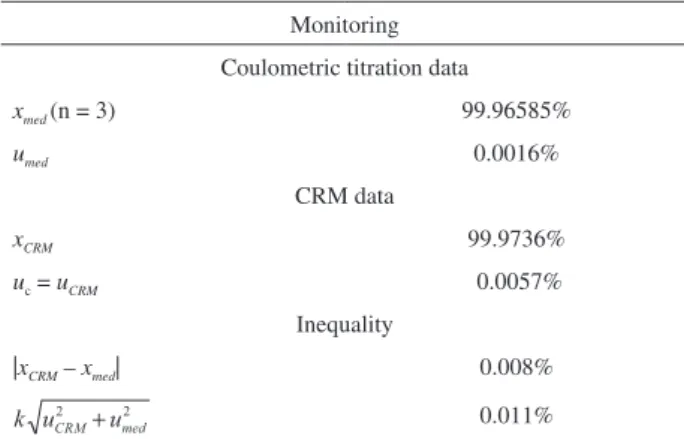Article
Printed in Brazil - ©2014 Sociedade Brasileira de Química0103 - 5053 $6.00+0.00A
*e-mail: ppborges@inmetro.gov.br
International Comparisons for Coulometric Determinations of Dichromate Used to
Develop Certified Reference Material for Oxidation-Reduction Titration
Paulo P. Borges* and Wiler B. da Silva Junior
Chemical Metrology Division, Electrochemistry Laboratory, National Institute of Metrology, Quality and Technology (Inmetro), Av. Nossa Senhora das Graças, 50, Prédio 4,
25250-020 Duque de Caxias-RJ, Brazil
Inicialmente, para adquirir experiência na determinação coulométrica da pureza do dicromato, realizou-se uma comparação bilateral entre os institutos nacionais de metrologia (INM) do Brasil e da Rússia. Em seguida, objetivando comparar os resultados das medições do dicromato de potássio (K2Cr2O7) entre os INM que utilizam a coulometria com elevada precisão para certificar
materiais de referência (MR) de compostos puros, o Inmetro participou de uma comparação-chave denominada CCQM-K96. A partir dessas comparações, certificou-se um lote do MR de K2Cr2O7. Este trabalho objetiva apresentar os resultados das comparações internacionais, bem
como os estudos necessários ao desenvolvimento do material de referência certificado (MRC) de K2Cr2O7 tornando-o um padrão primário para titulações de oxirredução. Para o lote certificado,
considerou-se tanto os estudos de homogeneidade quanto de caracterização, obtendo-se o valor da pureza, em fração mássica do K2Cr2O7 de 99,974% ± 0,011%, para k = 2 e probabilidade de
abrangência de aproximadamente 95%.
Initially, for acquiring experience in determining the purity of the dichromate by coulometry, a bilateral comparison between the national metrology institutes (NMIs) from Brazil and Russia was carried out. Next, to evaluate the comparability of the measurement results among the NMIs that use high-precison constant-current coulometry for certifying reference materials (RMs) of pure compounds, National Institute of Metrology, Quality and Technology (Inmetro) participated in a key-comparison named CCQM-K96. Because of both comparisons, a batch of the RM of K2Cr2O7 was certified. This work aims to present the international comparison results, as well as
the studies needed to develop a certified reference material (CRM) of K2Cr2O7 for redox titrations.
In the certification of the batch, studies of homogeneity and characterization were considered. The K2Cr2O7 batch was certified in mass fraction of 99.974% ± 0.011%, for k = 2 and coverage
probability of approximately 95%.
Keywords: certified reference material, precise coulometric titration, potassium dichromate, comparability
Introduction
The Chemical Metrology Division of the National Institute of Metrology, Quality and Technology (Inmetro) must, among other main duties, develop, produce, and provide certified reference materials (CRMs) for the community to ensure the quality of chemical analyses. The Electrochemistry Laboratory1 is located within the facilities on campus. Three primary methods of measurements2,3 were used including the primary system of coulometry (PSC).4 The PSC ensures the traceability of measurement
processes are almost finished, such as with potassium chloride and sodium chloride for precipitation.11 Since accurate certified values and uncertainties are needed to obtain reliable measurements,12 after the certification process, these CRMs are offered to the scientific, academic, and industrial communities.
In this work, the chemical compound potassium dichromate (K2Cr2O7) was selected as a candidate CRM. It is an oxidizing agent used as the primary standard for volumetric analysis of redox reactions.13 In addition to the high purity of the primary standards, they are also extremely stable when stored.14 Therefore, a batch of K
2Cr2O7 was prepared and the certification process was initiated. This certification process consists of the studies of homogeneity, characterization, and stability.9,15 Due to the high stability of the chosen material, stability studies did not need to be carried out.9,14 It is important to highlight that, after being certified, the material is constantly monitored to determine whether its property value is stable during its shelf life.9,16
The homogeneity is the condition of uniform structure or composition with respect to one or more specific properties.16 For studies of homogeneity of the candidate CRM of K2Cr2O7, the purity parameter was evaluated and expressed as a mass fraction; this is the weight percentage of potassium dichromate taken from the random samples of the batch material, which is analyzed by coulometric titration.6
The characterization is a process of determining the property values of a reference material. For the characterization of a reference material, a primary method of measurement can usually be used with the highest metrological quality, or two independent reference methods. Therefore, the characterization of the candidate CRM of K2Cr2O7 was performed only by a high-precision constant-current coulometry, which is considered a primary method.6,17-20
However, a bilateral comparison between the NMIs from Brazil and Russia was carried out in order to acquire experience for coulometric determination of the purity of the dichromate.21 Samples from the batch of the candidate CRM of K2Cr2O7 were then used in this bilateral comparison.
As an NMI, Inmetro ensures the quality of its results by participating in international comparisons under the Consultative Committee for Amount of Substance-Metrology in Chemistry (CCQM).22,23 After the bilateral comparison, the ability of Inmetro to determine the concentration of dichromate using high-precision current-constant coulometry was evaluated in the key comparison CCQM-K96.24 In this key comparison, a sample of potassium dichromate was sent to each of the participating
NMIs by the coordinating laboratory, and the comparability among the NMIs was reported.
This work aims to present the international comparison results, as well as the studies needed to certify a batch of a candidate CRM of K2Cr2O7 for redox titrations.
Experimental
The batch of the candidate CRM of K2Cr2O7
Potassium dichromate of analytical grade from Spectrum, weighing 500 g, was placed in a plastic tray, mixed, and homogenized with a porcelain spatula. All material was crushed manually by using a porcelain mortar. Once crushed, the material was homogenized, quartered, and, finally, homogenized again. Sub samples of the material totaling approximately 25 g, as weighed in a Mettler Toledo balance with a resolution of 1.0 mg, were filled in glass flasks, sealed with screw caps, and wrapped in a thin layer of Parafilm®. The small batch of the prepared candidate CRM contained 20 identified samples and they were numbered in order of weight.
Homogeneity studies
The homogeneity studies of the candidate CRM of K2Cr2O7 were developed expressing the property value as the purity of K2Cr2O7 in a mass fraction (%). Its value is related to the concentration expressed in the amount content (mol kg−1) of K
2Cr2O7 determined by precise coulometric titration6,7 as well as characterization studies.
Three bottles from the batch of the candidate CRM of K2Cr2O7 were randomly chosen for the homogeneity studies. Before being used, the samples were dried in an oven at 110 °C for 2 h, and they were then stored inside the desiccator.
For the data treatment, the Grubbs test was first used for the exclusion of outliers that could interfere with the final results. Next, according to the ISO Guide 35 criteria,9 the homogeneity of the batch of the candidate CRM of K2Cr2O7 was studied using an Analysis of Variance (ANOVA) approach.16
Characterization studies: precise coulometric titration
The previously described PSC8 and precise coulometric titration with biamperometric end-point detection were used as analytical methods for determining the content amount of dichromate in mol kg−1 or in a mass fraction (%) calculated by using the Faraday constant, F = 96 485.3383 C mol−1 and
M = 294.1846 g mol−1, as the molar mass of K
reagents were of analytical grade, and deionized water (with electrolytic conductivity equal or less than 0.1 µS cm−1) was used with all prepared solutions.
The coulometric cell is made of glass with a vertical design containing two separated compartments: the cathodic and the anodic. Figure 1 shows a diagram of the coulometric cell. The anodic compartment (anolyte) was filled with 2.0 mol L−1 H
2SO4. It contained a silica gel (silicate) plug in its base that stayed inside the intermediate compartment (IC), which, in its base, included is a sintered glass plug. The silica gel plug was prepared with silicate solution in 2.0 mol L-1 H
2SO4. Both plugs were needed to separate the catholyte from the anolyte and to maintain the electrolytic contact. The supporting electrolyte (250 mL) was a solution of 0.4 mol L−1 ammonium iron (III) sulfate and 2.0 mol L−1 H
2SO4. The indicator electrode used for end-point detection was a double platinum electrode (two Pt wire of 1 mm diameter each). A voltage of 0.050 V was applied between the two wires of the indicator electrode. Two platinum electrodes were immersed in the coulometric cell: a generation electrode (WE) made of a large Pt plate (with dimensions 5 cm × 6 cm × 0.04 cm) and a counter electrode (CE) made of a Pt plate (0.3 mm thickness) with a 1 cm2 area. The sample of K
2Cr2O7 was dried at 110 °C for 2 h and then cooled in desiccators over silica pellets.
The current required for coulometric titration of a dichromate sample (ca. 0.5 g weighed by using a microbalance Mettler Toledo UMX 5, resolution of 0.1 µg) was passed on three different phases. For the initial titration, a current of 0.004 A was used, a current of 0.3 A was used for the main titration, and for the final titration, a current of
0.004 A was again used. All the weighing was corrected for buoyancy and the coulometric cell was maintained at 23 °C during the experiment. Initially, argon gas with a high purity (99.999%) was passed through the cathodic compartment for deaeration, after it stayed above the compartment during the titration phases.
All the titration phases were carried out with the catholyte stirred by means of a magnetic stirrer. The end-point for each titration was calculated using linear regression up to eight points from the curve t (s) versus I (mA). Before each measurement, the two electrodes (WE and indicator) were first immersed for 10 min in a concentrated solution of K2Cr2O7. After that, they were washed in deionized water and immersed for 10 min in a solution of 0.2 mol L−1 ammonium iron (II) sulfate and then they were washed in deionized water. After the first cleaning, the three electrodes (CE included) were immersed in a hot concentrated nitric acid of an analytical grade for 5 min and then washed with deionized water. At the start of each measurement, a volume of approximately 100-200 µL of 0.005 mol L−1 K
2Cr2O7 was added to the supporting electrolyte.
Before the main titration began, about 10 min was needed for the K2Cr2O7 sample to be dissolved. Fifteen minutes before the main titration was finished, the indicator electrode was rinsed within the cell with deionized water and then taken off the cathodic compartment for cleaning. This precaution was needed to avoid the oxide film formed on the platinum electrode that could affect the behavior of the ferrous-ferric couple,20 therefore causing an error at the end-point detection. Thus, it was immersed for 10 min in a solution of 2.0 mol L−1 ammonium iron (II) sulfate and, after, it was washed with deionized water and again taken in the catholyte.
Results and Discussion
Bilateral comparison
Two samples of potassium dichromate were used for the comparison: the NMI of Brazil (Inmetro) provided one sample and the NMI of Russia (UNIIM) provided another. In this bilateral comparison, both PSCs from each NMI were benchmarked for the further development of CRMs for oxidimetric analysis. Table 1 presents the figure of merits for the samples from Inmetro. In this table, the mean results of the amount content of potassium dichromate (mol kg−1), combined with a standard uncertainty (u
c), a relative combined standard uncertainty (uc,r), a relative standard deviation (RSD), and a number of measurements (n) are reported. These results were considered comparable
due to the uncertainty of the measurements according to the Guide to the expression of Uncertainty in Measurement (GUM).25 Figure 2 graphically demonstrates the results of the samples from Inmetro achieved by the two NMIs. In this bilateral, the results from Inmetro were used to characterize the K2Cr2O7 from the batch of the candidate CRM, as will be shown going forward.
Key comparison CCQM-K96
The complete measurement results of the key comparison CCQM-K96 were reported elsewhere.24 In Figure 3, the results from the participating NMIs are shown. The results of the CCQM-K96 revealed a positive agreement between most participating laboratories for the measurement of potassium dichromate by precise constant-current coulometry. The reference value for this comparison was (3.39705 ± 0.00016) mol kg−1; on the other hand, the value determined by Inmetro was (3.39670 ± 0.00028) mol kg−1, both for k = 2, and with a coverage probability of approximately 95%. Therefore, the coulometric titration procedure was evaluated, showing comparability among the NMIs. Because of the positive results achieved by Inmetro in this key comparison, it was possible to certify the batch of the potassium dichromate reliably.
Certification of the candidate CRM of K2Cr2O7
Homogeneity studies
Studies of homogeneity were carried out on three samples randomly chosen from the batch of the candidate CRM and analyzed in four replicates with the use of precise coulometric titration.
The results from coulometric titration for the new studies of homogeneity to the candidate CRM of K2Cr2O7 and the ANOVA testing are presented in Tables 2 and 3, respectively.
One can observe that F < Ftable for P-value > 0.005, which is considered to have no significant difference between the samples. Thus, it can be inferred that the samples of the candidate CRM of K2Cr2O7 are considered homogeneous. The uncertainty regarding the homogeneity studies was equivalent to uhom = 0.0034%. In addition, uhom will be one of the sources of uncertainty for the CRM. The last uncertainty to be considered for certification of the candidate CRM is related to the uncertainty of characterization (uchar). Due to
Table 1. Measurement results of the bilateral comparison of the samples from Inmetro
NMI Result / (mol kg−1) u
c / (mol kg
−1) u
c,r / % RSD / % n
Inmetro 3.398329 0.000155 0.005 0.003 7
UNIIM 3.398937 0.000300 0.009 0.009 7
Figure 2. Results of the bilateral comparison of K2Cr2O7 of the samples from Inmetro. The dashed line represents the mean value and the straight line represents the weighted mean value. Error bar corresponds to the expanded uncertainties considering k = 2, for a coverage probability of approximately 95%. The mass fractions (%) that correspond to the amount contents can be seen on the right side.
Table 2. Results from coulometric titration of the candidate CRM for homogeneity testing
na
Mass fraction / %
Sample
4 9 13
1 99.98048 99.96194 99.97913
2 99.96667 99.98377 99.97281
3 99.98946 99.98240 99.98700
4 99.99352 99.97799 99.98746
Mean 99.98253 99.97652 99.98160
RSDb / % 0.012 0.010 0.007
an: number of replicates; bRSD: relative standard deviation.
the high stability of the dichromate,14 the stability studies were not taken into account, therefore, the uncertainty of the stability of the CRM was considered null.
Characterization studies
The characterization of the candidate CRM, which will assign the value of the property certified for the CRM of K2Cr2O7, was obtained by the mean results from seven replicates performed by precise constant-current coulometric titration. Table 4 shows the results of characterization of the candidate CRM of K2Cr2O7, whose mean value for its purity, in a mass fraction, was equivalent to 99.97361%.
Table 5 illustrates the uncertainty budget, considering
the GUM and EURACHEM/CITAC approach,25,26 for
the coulometric characterization of the candidate CRM of K2Cr2O7. The main contributions to the uncertainty evaluation were the current (66.0%), followed by the influence of the oxygen from the air in the coulometric cell (17.4%). The purity of the candidate CRM characterized by precise current-constant coulometric titration yielded the value of 99.9736% ± 0.0091%. This value is equivalent to (3.39833 ± 0.00031) mol kg−1 as the amount content, for
k = 2 with a coverage probability of approximately 95%. Figure 4 shows the mean results for the characterization of the candidate CRM of K2Cr2O7 by precise coulometric titration and their expanded uncertainties.
For the developed CRM of K2Cr2O7, the combined standard uncertainty (uc) of the CRM will be calculated by means of equation 1.
(1)
The certification process for the candidate CRM of K2Cr2O7 is completed with the evaluation of the uncertainty of the CRM. Taking into account the uncertainties related to the studies of homogeneity (uhom = 0.0034%) and characterization (uchar = 0.0046%), the uc of the CRM was
Table 3. Analysis of variance for testing the homogeneity of the candidate CRM K2Cr2O7, calculated with the coulometric titration data
Variation source SSa dfb MSc F P-value F
table
Among 8.362 × 10−5 2 4.181 × 10−5 0.431 0.663 4.256
Within 8.733 × 10−4 9 9.703 × 10−5 − − −
Total 9.569 × 10−4 11 − − − −
aSS: sums of squares; bdf: degrees of freedom; cMS: mean squares.
Table 4. Characterization results of the candidate CRM of K2Cr2O7
na Amount content /
(mol kg−1)
Mass fraction / %
1 3.398417 99.97620
2 3.398426 99.97646
3 3.398339 99.97390
4 3.398201 99.96983
5 3.398278 99.97212
6 3.398412 99.97604
7 3.398230 99.97071
Mean 3.398329 99.97361
RSDb / % 0.003 0.003
an: number of replicates; bRSD: relative standard deviation.
Table 5. Uncertainty budget for characterization of the candidate CRM of K2Cr2O7
Source Standard uncertainty,
ui (x)
Unit Sensitivity coefficient, ci
Uncertainty contribution, ui(ν)
Relative contribution,
ui(ν) / %
Repeatability 3.5 × 10−5 mol kg−1 1 3.5 × 10−5 5.2
Weighing 8.5 × 10−10 kg 3.8 × 103 3.2 × 10−6 0.04
Buoyancy correction 1.9 × 10−7 1 43.4 8.3 × 10−6 0.3
Time 8.7 × 10−7 s 10.4 9.0 × 10−6 0.33
Current 1.0 × 10−5 A 12.2 1.2 × 10−4 66.0
Faraday constant 5.8 × 10−5 mol (A s)−1 1.5 × 10−1 9.0 × 10−6 0.33
End-point detection 1.4 × 10−5 mol kg−1 1 1.4 × 10−5 0.8
Chemical correction 2.6 × 10−5 mol kg−1 1 2.6 × 10−5 2.7
Incomplete rinsing 2.0 × 10−5 mol kg−1 1 2.0 × 10−5 1.6
Current efficiency 2.3 × 10−5 mol kg−1 1 2.3 × 10−5 2.1
Electrolyte impurities 2.0 × 10−5 mol kg−1 1 2.0 × 10−5 1.6
O2 influence 6.5 × 10−5 mol kg−1 1 6.5 × 10−5 17.4
Diffusion 2.0 × 10−5 mol kg−1 1 2.0 × 10−5 1.6
Combined uncertainty, uc (ν) 1.5 × 10−4 mol kg−1
Figure 4. The measurement results for characterization of the candidate CRM of K2Cr2O7. The solid line represents the certified value (mean from seven results), where each bar represents ± the expanded uncertainty from the coulometric titration; the dashed lines represent the expanded uncertainty from the certified value, both for a coverage probability of approximately 95%.
equivalent to 0.0057%. Thus, the CRM of K2Cr2O7 was certificated with the value 99.974% ± 0.011% (k = 2, with a coverage probability of approximately 95%).
Monitoring studies were conducted in order to observe the stability of the material after its certification. Because it is a pure chemical solid compound, monitoring should verify whether the value of the certificate is confirmed in time, considering the limits of the expanded uncertainty from the certified material. According to the ISO Guide 35,9 inequality 2 is used for monitoring the CRM.
(2)
where: xCRM is the property value of the CRM; xmed is the observed value during the measurement; k is the coverage factor for coverage probability of 95%.; uCRM is the uncertainty of the CRM; and umed is the uncertainty related to the measurement. In this case, if the material can be considered stable, both the property value and the expanded uncertainty are confirmed.
Table 6 illustrates the figure of merits for monitoring the CRM of K2Cr2O7 by precise coulometric titration three months after it has been certified.
Utilizing the data from Table 6, the results obtained confirm that the CRM continues to be stable, since the results from inequality 2 are true. It is worth noting that the monitoring of the batch of the CRM will continue every six months during its shelf life.
Conclusion
Both results from the bilateral comparison and CCQM-K96 for the assay of potassium dichromate by precise constant-current coulometric titration contributed to the reliability and experience in developing a CRM of potassium dichromate.
The candidate CRM of potassium dichromate was characterized by the PSC with a value of 99.9736% and an uncertainty characterization equivalent to uchar = 0.0046%. The material was considered homogeneous by coulometry, with uncertainty uhom = 0.0034%. Thus, combining the uncertainties from the homogeneity and characterization studies, the CRM of K2Cr2O7 was certified as 99.974% ± 0.011%, for k = 2 with a coverage probability of approximately 95%. On the other hand, the first monitoring of the CRM showed that the certified value was confirmed.
This CRM will contribute to ensuring the reliability and traceability of the measurement results that require potassium dichromate as a primary standard in redox titrations.
Acknowledgements
One of the authors (Wiler Batista da Silva Junior) would like to thank the Brazilian Ministry of Development, Industry and Foreign Trade (MDIC), and the Research Support Foundation of the State of Rio de Janeiro (Faperj E-26/103.635/2012), which has provided financial support as fellowship to develop this research at Inmetro.
References
1. h t t p : / / w w w. i n m e t r o . g ov. b r / m e t c i e n t i fi c a / q u i m i c a / eletroquimica.asp accessed in September 2013.
2. Richter, W.; Accredit. Qual. Assur. 1997, 2, 354. 3. Milton, M. J. T.; Quinn, T. J.; Metrologia 2001, 38, 289. 4. Máriássy, M.; Vyskocil, L.; Mathiasová, A.; Accred. Qual. Assur.
2000, 5, 437.
5. http://www.bipm.org/utils/common/pdf/si_summary_en.pdf accessed in September 2013.
6. Bishop, E.; In: Comprehensive Analytical Chemistry; Wilson, C. L.; Wilson, D. W., eds.; Elsevier: New York, 1975. 7. Máriássy, M.; Pratt, K. W.; Spitzer, P.; Metrologia 2009, 46,
199. Table 6. Monitoring of the CRM of K2Cr2O7
Monitoring
Coulometric titration data
xmed (n = 3) 99.96585%
umed 0.0016%
CRM data
xCRM 99.9736%
uc = uCRM 0.0057%
Inequality
|xCRM – xmed| 0.008%
8. Pratt, K. W.; Anal. Chim. Acta 1994, 289, 125.
9. ISO Guide 35: Reference materials - General and statistical principles for certification, 3rd. ed., ISO: Geneva,2006.
10. http://www.inmetro.gov.br/metcientifica/MRC/mrc_8483.asp accessed in September 2013.
11. Borges, P. P.; Sobral, S. P.; Silva, L.; Araujo, T. O.; Silva, R. S.;
J. Braz. Chem. Soc. 2011, 10, 1931.
12. Valcárcel, M.; Ríos, A.; Anal. Chim. Acta 1999, 400, 425. 13. Sawyer, D. T.; Sobkowiak, A.; Roberts Jr., J. L.; Electrochemistry
for Chemists, 2nd ed.; Wiley: New York, 1995.
14. Stenger, V. A.; Anal. Chem. 1951, 23, 1540
15. Van Der Veen, A. M. H.; Linsinger, T. P. J.; Schimmel, H.; Lamberty, A.; Pauwels, J.; Accredit. Qual. Assur. 2001, 6, 290. 16. Van der Veen, A. M. H.; Linsinger, T.; Pauwels, J.; Accredit.
Qual. Assur. 2001, 6, 20.
17. Marinenko, G.; Taylor, J. K.; J. Res. Natl. Bur. Stand. 1963, 67A, 5, 453.
18. Asakai, T.; Kakihara, Y.; Kozuka, Y.; Hossaka, S.; Murayama, M.; Tanaka, T.; Anal. Chim. Acta 2006, 567, 269.
19. Asakai, T.; Hioki, A.; Accredit. Qual. Assur. 2011, 17, 45. 20. Skutina, A. V.; Terentiev, G. I.; Meas. Tech. 2011, 9, 964. 21. Yoshimori, T.; Reviews in Analytical Chemistry 1982, 6, 13. 22. http://www.bipm.fr/en/cipm-mra accessed in September 2013. 23. Quinn, T.; Accredit. Qual. Assur. 2004, 9, 533.
24. Máriássy, M.; Hanková, Z.; Hwang, E.; Lim,Y.; Pratt, K. W.; Hioki, A.; Asakai, T.; Bing, W.; Liandi, M.; Chao, W.; Sobina, A.; Shimolin, A.; Silva Junior, W. B.; Borges, P. P.; Matehuala, F. J.; Segoviano, F.; Rivera, G.; Ramírez, P.; Arvizu, M. R.; Ortiz-Aparicio, J. L.; Metrologia2013, 50. Doi:10.1088/0026-1394/50/1A/08012.
25. Joint Committee for Guides in Metrology (JCGM); Evaluation of measurement data - Guide to the expression of uncertainty
in measurement, JCGM 100: 2008.
26. EURACHEM/CITAC; Guide Quantifying Uncertainty in Analytical Measurement, 3rd ed., 2011.
Submitted on: September 29, 2013



